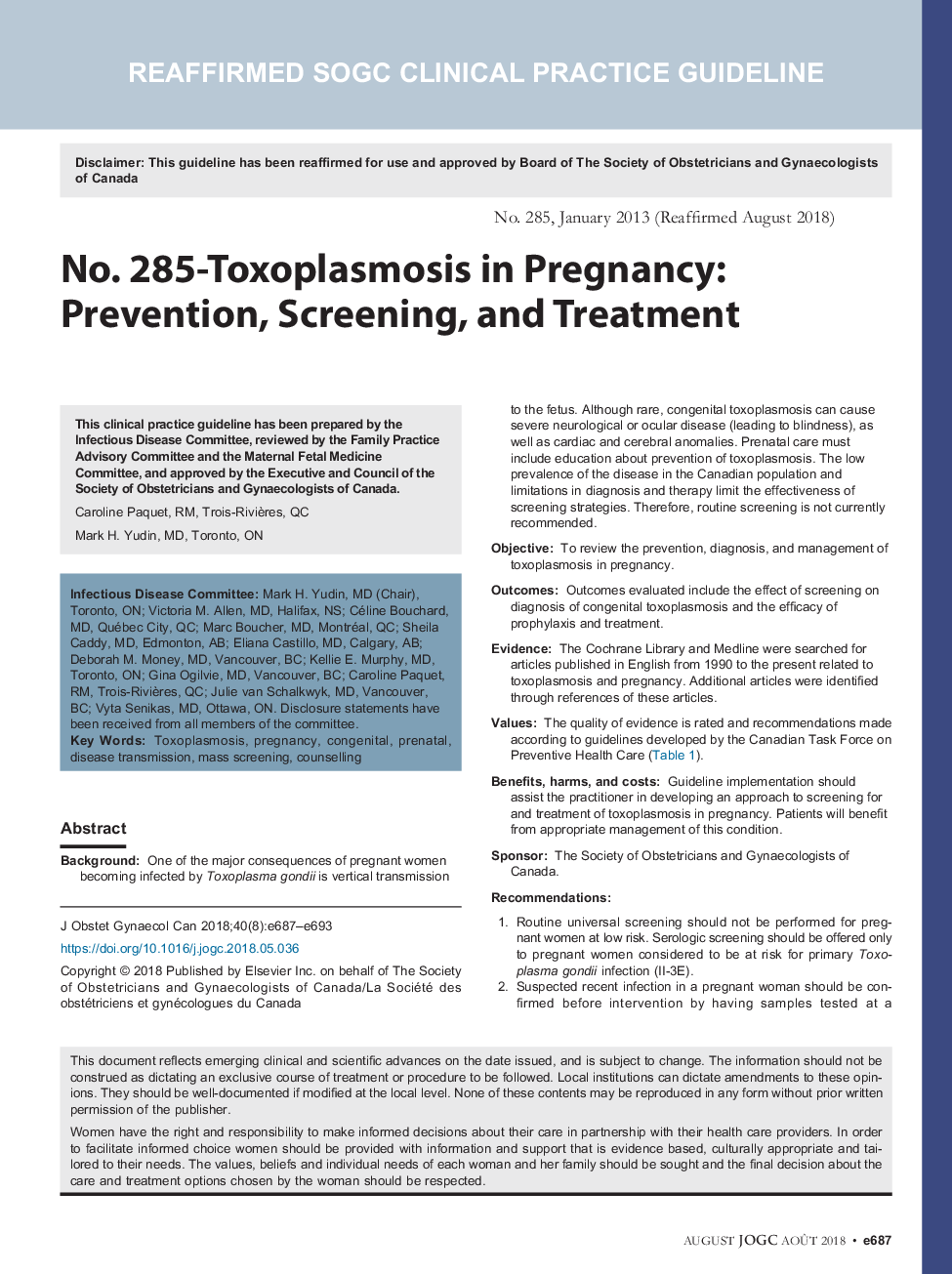| کد مقاله | کد نشریه | سال انتشار | مقاله انگلیسی | نسخه تمام متن |
|---|---|---|---|---|
| 8781522 | 1600642 | 2018 | 7 صفحه PDF | دانلود رایگان |
عنوان انگلیسی مقاله ISI
No. 285-Toxoplasmosis in Pregnancy: Prevention, Screening, and Treatment
ترجمه فارسی عنوان
شماره 285-توکسوپلاسموز در بارداری: پیشگیری، غربالگری و درمان
دانلود مقاله + سفارش ترجمه
دانلود مقاله ISI انگلیسی
رایگان برای ایرانیان
کلمات کلیدی
توکسوپلاسموز، بارداری، مادرزادی قبل از تولد، انتقال بیماری، غربالگری توده، مشاوره،
موضوعات مرتبط
علوم پزشکی و سلامت
پزشکی و دندانپزشکی
زنان، زایمان و بهداشت زنان
چکیده انگلیسی
BackgroundOne of the major consequences of pregnant women becoming infected by Toxoplasma gondii is vertical transmission to the fetus. Although rare, congenital toxoplasmosis can cause severe neurological or ocular disease (leading to blindness), as well as cardiac and cerebral anomalies. Prenatal care must include education about prevention of toxoplasmosis. The low prevalence of the disease in the Canadian population and limitations in diagnosis and therapy limit the effectiveness of screening strategies. Therefore, routine screening is not currently recommended.ObjectiveTo review the prevention, diagnosis, and management of toxoplasmosis in pregnancy.OutcomesOutcomes evaluated include the effect of screening on diagnosis of congenital toxoplasmosis and the efficacy of prophylaxis and treatment.EvidenceThe Cochrane Library and Medline were searched for articles published in English from 1990 to the present related to toxoplasmosis and pregnancy. Additional articles were identified through references of these articles.ValuesThe quality of evidence is rated and recommendations made according to guidelines developed by the Canadian Task Force on Preventive Health Care (Table 1).Benefits, harms, and costsGuideline implementation should assist the practitioner in developing an approach to screening for and treatment of toxoplasmosis in pregnancy. Patients will benefit from appropriate management of this condition.SponsorThe Society of Obstetricians and Gynaecologists of Canada.Recommendations1.Routine universal screening should not be performed for pregnant women at low risk. Serologic screening should be offered only to pregnant women considered to be at risk for primary Toxoplasma gondii infection (II-3E).2.Suspected recent infection in a pregnant woman should be confirmed before intervention by having samples tested at a toxoplasmosis reference laboratory, using tests that are as accurate as possible and correctly interpreted (II-2B).3.If acute infection is suspected, repeat testing should be performed within 2 to 3 weeks, and consideration given to starting therapy with spiramycin immediately, without waiting for the repeat test results (II-2B).4.Amniocentesis should be offered to identify Toxoplasma gondii in the amniotic fluid by polymerase chain reaction (a) if maternal primary infection is diagnosed, (b) if serologic testing cannot confirm or exclude acute infection, or (c) in the presence of abnormal ultrasound findings (intracranial calcification, J Obstet Gynaecol Can 2013;35(1 eSuppl A):S1-S7 microcephaly, hydrocephalus, ascites, hepatosplenomegaly, or severe intrauterine growth restriction) (II-2B).5.Amniocentesis should not be offered for the identification of Toxoplasma gondii infection at less than 18 weeks' gestation and should be offered no less than 4 weeks after suspected acute maternal infection to lower the occurrence of false-negative results (II-2D).6.Toxoplasma gondii infection should be suspected and screening should be offered to pregnant women with ultrasound findings consistent with possible TORCH (toxoplasmosis, rubella, cytomegalovirus, herpes, and other) infection, including but not limited to intracranial calcification, microcephaly, hydrocephalus, ascites, hepatosplenomegaly, or severe intrauterine growth restriction. (II-2B)7.Each case involving a pregnant woman suspected of having an acute Toxoplasma gondii infection acquired during gestation should be discussed with an expert in the management of toxoplasmosis (III-B).8.If maternal infection has been confirmed but the fetus is not yet known to be infected, spiramycin should be offered for fetal prophylaxis (to prevent spread of organisms across the placenta from mother to fetus) (I-B).9.A combination of pyrimethamine, sulfadiazine, and folinic acid should be offered as treatment for women in whom fetal infection has been confirmed or is highly suspected (usually by a positive amniotic fluid polymerase chain reaction) (I-B).10.Anti-toxoplasma treatment in immunocompetent pregnant women with previous infection with Toxoplasma gondii should not be necessary (I-E).11.Women who are immunosuppressed or HIV-positive should be offered screening because of the risk of reactivation and toxoplasmosis encephalitis (I-A).12.A non-pregnant woman who has been diagnosed with an acute Toxoplasma gondii infection should be counselled to wait 6 months before attempting to become pregnant. Each case should be considered separately in consultation with an expert (III-B).13.Information on prevention of Toxoplasma gondii infection in pregnancy should be made available to all women who are pregnant or planning a pregnancy (III-C).
ناشر
Database: Elsevier - ScienceDirect (ساینس دایرکت)
Journal: Journal of Obstetrics and Gynaecology Canada - Volume 40, Issue 8, August 2018, Pages e687-e693
Journal: Journal of Obstetrics and Gynaecology Canada - Volume 40, Issue 8, August 2018, Pages e687-e693
نویسندگان
Caroline RM, Mark H. MD,
